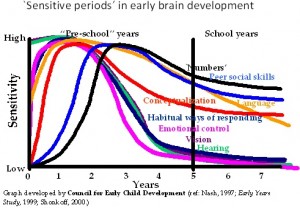The last Wednesday in February is Pink Shirt Day (different in some areas). This special day started in Canada in 2007 by 2 high school boys who saw a younger boy being bullied for wearing a pink shirt to school. Asking their friends to wear pink shirts or using 50 they had purchased they banded with this student and sent a message to the bullies. The day–and the message– are spreading around the world.
 How is this relevant for toddlers and preschoolers? Would you believe that the peak sensitive period for ways to respond to others is between the ages of 1 and 3 years? That’s the dark blue line in the chart. We neither want our children to respond to others with passive fear or aggressive action. Helping little ones learn about their feelings and emotions is a key. We can do this by giving them the name or label for emotions, such as “I see you are really upset. Could it be you are sad?” or “I see you look really tight and hard. Could it be you are angry?” and so on. Practicing figuring out what others are feeling by the look on their faces is another way to help. Helping children to talk about their feelings is another.
How is this relevant for toddlers and preschoolers? Would you believe that the peak sensitive period for ways to respond to others is between the ages of 1 and 3 years? That’s the dark blue line in the chart. We neither want our children to respond to others with passive fear or aggressive action. Helping little ones learn about their feelings and emotions is a key. We can do this by giving them the name or label for emotions, such as “I see you are really upset. Could it be you are sad?” or “I see you look really tight and hard. Could it be you are angry?” and so on. Practicing figuring out what others are feeling by the look on their faces is another way to help. Helping children to talk about their feelings is another.
 Instead of calling other people names, it’s important to teach kids to use “I messages”: “I don’t like when you take my toys. I feel sad when you tease me. I don’t like when you won’t give me a turn.” These are all “I messages.” We also need to give our kids some behavior boundaries, for instance, “It’s okay to be mad. It’s not okay to hurt others,” and some alternatives like ignoring, playing in a different space or with a different toy, or talking to the other person. And we need to let children know it’s okay to ask for help. They have a right to be safe and protected. These are life skills, not just social and emotional readiness for kindergarten and will help little ones as they interact with others. Will you wear a pink shirt on Wednesday and spread the message?
Instead of calling other people names, it’s important to teach kids to use “I messages”: “I don’t like when you take my toys. I feel sad when you tease me. I don’t like when you won’t give me a turn.” These are all “I messages.” We also need to give our kids some behavior boundaries, for instance, “It’s okay to be mad. It’s not okay to hurt others,” and some alternatives like ignoring, playing in a different space or with a different toy, or talking to the other person. And we need to let children know it’s okay to ask for help. They have a right to be safe and protected. These are life skills, not just social and emotional readiness for kindergarten and will help little ones as they interact with others. Will you wear a pink shirt on Wednesday and spread the message?
